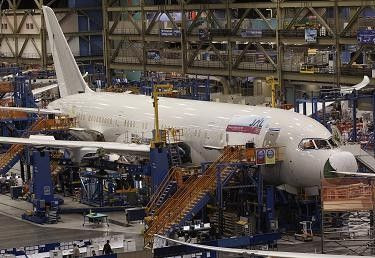Under the Radar: Is Globalization Keeping U.S. Jobless Claims High?

Under the radar: Some trends are obvious enough and are visible to all investors/readers. Others are more-subtle, but are just as potent, and these often slip 'under the radar.'
Case in point: The normal U.S. labor market pattern is for initial jobless claims to decline substantially, as company lay-offs subside and as more companies maintain current staffing levels, and start hiring. But what if jobless claims persist at a high level, even after the U.S. economy reaches the condition of a strong expansion? That would be indicative of another dynamic in the U.S. job market.
U.S. initial jobless claims as tabluated by the U.S. Department of Labor have declined about 31.5% over the past two years to 444,000 from 625,000 in May 2009, something you'd expect as a recovery begins.
Even so, jobless claims need to drop below 400,000 -- and remain below that level -- to give economists and investors confidence that commercial activity is increasing at a pace that prompts most companies to curtail lay-offs and resume hiring. Further, it's hiring that forms the foundation for a sustainable expansion.
In a nutshell, here's the importance of hiring in relation to the economic expansion: the nation has to add about 100,000 to 125,000 net new jobs per month, just to keep the unemployment rate -- currently a high 9.1% -- from rising. Also, the nation needs to add about 200,000 to 250,000 net new jobs per month to substanially lower that costly, high unemployment.
What's more, in general, as jobless claims decline -- particularly as the metric falls below 400,000 -- job growth rises and the uenmployment rate declines, at least that's been the case in the modern era.
However, if jobless claims remain high -- for example above 400,000 - in the face of job growth of 150,000 and 200,000 per month etc., that would suggest that another, irregular dynamic is at work in the U.S.: that job churn is persisting even as the U.S. economy starts to add jobs in a big way. Usually in the U.S. economy it's one or the other: a high level of job layoffs or a high level of job growth. The current expansion may break that norm: a high level of job layoffs even as the economy experiences a high level of job growth.
Further, the factors that could drive the above phenomenon could be multiple (mergers, increased worker productivity, automation, among others), but at the top of the list would be -- your guessed it -- globalization. It's conceivable that globalization will continue to force the U.S. economy to restructure at a high rate - with the accompanying job churn - even as it adds millions of jobs per year.
If the latter occurs, it would represent a new challenge for policy makers, business executives, and economists alike. Changes would have to occur in the U.S.'s social safety net (including changes in unemployment compensation, job training, and college education subsidies for retraining) to cope with lingering, high jobless claims, and the dislocation it implies.
Public Policy/Economic Analysis: But let's not get ahead of ourselves. Again, we're too young in the U.S. economic recovery to draw any meaningful conclusions regarding the persistence of high (above 400,000) initial jobless claims, but if initial claims do not fall below 400,000 in the second half of 2011 and then below 375,000 in 2012, we'll know that some other factor(s) is hindering the decline in jobless claims to normal, lower levels, and the transfer of jobs to lower-cost production centers outside the U.S. could very well be at the top of that list.
In the winter 2011, jobless claims rose after briefly dipping below the 400,000-level, but not enough data is available to incontrovertibly state the cause. It could have been due to cyclical or one-time ideosyncratic factors, not related to globalization, such as: 1) the earthquake/tsunami in Japan that affected the manufacturing/information technology supply chain, slowing U.S./European growth and/or 2) the Libyan civil war in 2011, which added about $20 to oil's price, further slowing global GDP growth.
© Copyright IBTimes 2025. All rights reserved.





















